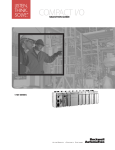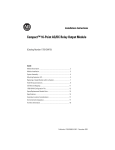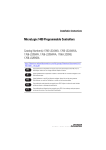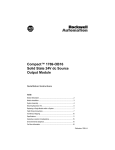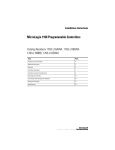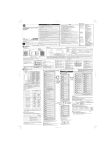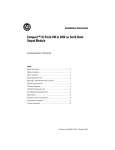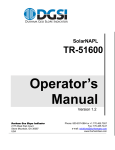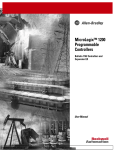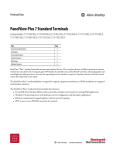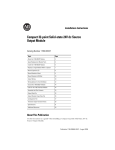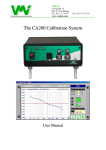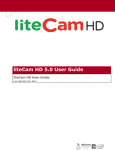Download Installation Instructions
Transcript
Installation Instructions Compact Combination 24V dc Sink Input/Source Output BOOLEAN Control Module Catalog Number 1769-BOOLEAN Inside . . . For See Page About This Publication 1 About the 1769-BOOLEAN Module 5 Module Description 5 Install the 1769-BOOLEAN Module 6 Replace a Single Module Within a System 7 Mount Expansion I/O 8 Minimum Spacing 8 Mount Module to Panel 8 Wire the 1769-BOOLEAN Module 10 Ground the 1769-BOOLEAN Module 11 Configure the 1769-BOOLEAN Module 12 Specifications 22 Additional Resources 27 About This Publication Use this document as a guide when installing a Compact Combination 24V dc Sink Input/Source Output BOOLEAN Control Module. Publication 1769-IN077A-EN-P - May 2006 2 Important User Information Solid state equipment has operational characteristics differing from those of electromechanical equipment. Safety Guidelines for the Application, Installation and Maintenance of Solid State Controls (Publication SGI-1.1 available from your local Rockwell Automation sales office or online at http://rockwellautomation.com/literature) describes some important differences between solid state equipment and hard-wired electromechanical devices. Because of this difference, and also because of the wide variety of uses for solid state equipment, all persons responsible for applying this equipment must satisfy themselves that each intended application of this equipment is acceptable. In no event will Rockwell Automation, Inc. be responsible or liable for indirect or consequential damages resulting from the use or application of this equipment. The examples and diagrams in this manual are included solely for illustrative purposes. Because of the many variables and requirements associated with any particular installation, Rockwell Automation, Inc. cannot assume responsibility or liability for actual use based on the examples and diagrams. No patent liability is assumed by Rockwell Automation, Inc. with respect to use of information, circuits, equipment, or software described in this manual. Reproduction of the contents of this manual, in whole or in part, without written permission of Rockwell Automation, Inc., is prohibited. Throughout this manual, when necessary, we use notes to make you aware of safety considerations. WARNING IMPORTANT ATTENTION Identifies information about practices or circumstances that can cause an explosion in a hazardous environment, which may lead to personal injury or death, property damage, or economic loss. Identifies information that is critical for successful application and understanding of the product. Identifies information about practices or circumstances that can lead to personal injury or death, property damage, or economic loss. Attentions help you identify a hazard, avoid a hazard, and recognize the consequences. SHOCK HAZARD Labels may be located on or inside the equipment (for example, drive or motor) to alert people that dangerous voltage may be present. BURN HAZARD Labels may be located on or inside the equipment (for example, drive or motor) to alert people that surfaces may be dangerous temperatures. Publication 1769-IN077A-EN-P - May 2006 3 Prevent Electrostatic Discharge ATTENTION Electrostatic discharge can damage integrated circuits or semiconductors if you touch bus connector pins. Follow these guidelines when you handle the module: – – – – – – Touch a grounded object to discharge static potential. Wear an approved wrist-strap grounding device. Do not touch the bus connector or connector pins. Do not touch circuit components inside the module. If available, use a static-safe work station. When not in use, keep the module in its static-shield box. Remove Power ATTENTION Remove power before removing or inserting this module. When you remove or insert a module with power applied, an electrical arc may occur. An electrical arc can cause personal injury or property damage by: – sending an erroneous signal to your system’s field devices, causing unintended machine motion. – causing an explosion in a hazardous environment. Electrical arcing causes excessive wear to contacts on both the module and its mating connector. Worn contacts may create electrical resistance. Publication 1769-IN077A-EN-P - May 2006 4 Hazardous Location Considerations This equipment is suitable for use in Class I, Division 2, Groups A, B, C, D or non-hazardous locations only. The following WARNING statement applies to use in hazardous locations. WARNING EXPLOSION HAZARD • Substitution of components may impair suitability for Class I, Division 2. • Do not replace components or disconnect equipment unless power is switched off or the area is known to be non-hazardous. • Do not connect or disconnect components unless power is switched off or the area is known to be non-hazardous. • This product must be installed in an enclosure. • All wiring must comply with Class I, Division 2 wiring methods of Article 501 of the National Electrical Code and/or in accordance with Section 18-1J2 of the Canadian Electrical Code, and in accordance with the authority having jurisdiction. Environnements dangereux Cet équipement est conçu pour être utilisé dans des environnements de Classe 1, Division 2, Groupes A, B, C, D ou non dangereux. La mise en garde suivante s’applique à une utilisation dans des environnements dangereux. AVERTISSEMENT DANGER D’EXPLOSION • La substitution de composants peut rendre cet équipement impropre à une utilisation en environnement de Classe 1, Division 2. • Ne pas remplacer de composants ou déconnecter l'équipement sans s'être assuré que l'alimentation est coupée et que l'environnement est classé non dangereux. • Ne pas connecter ou déconnecter des composants sans s'être assuré que l'alimentation est coupée ou que l'environnement est classé non dangereux. • Ce produit doit être installé dans une armoire. Publication 1769-IN077A-EN-P - May 2006 5 About the 1769-BOOLEAN Module Compact I/O is suitable for use in an industrial environment when installed in accordance with these instructions. Specifically, this equipment is intended for use in clean, dry environments (Pollution degree 2(1)) and to circuits not exceeding Over Voltage Category II(2) (IEC 60664-1)(3). Module Description 1 2a OUT 2 IN Item Description 0 1 0 2 1 3 5 BOOLEAN 3 3 4 6 7 DANGER 1 Bus lever (with locking function) 2a Upper panel mounting tab 2b Lower panel mounting tab 3 Module status LED 4 Module door with terminal identification label 5a Movable bus connector with female pins 5b Stationary bus connector with male pins 6 Nameplate label 7a Upper tongue-and-groove slots 7b Lower tongue-and-groove slots 8a Upper DIN rail latch 8b Lower DIN rail latch 9 Write-on label (user ID tag) 10 Removable terminal block (RTB) with finger-safe cover 10a RTB upper retaining screw 10b RTB lower retaining screw Do Not Remove RTB Under Power Unless Area is Non-Hazardous 10a +VDC OUT 0 OUT 1 OUT 2 OUT DC COM OUT 3 N.C. N.C. N.C. 10 IN 0 IN 2 IN 1 IN 3 IN 4 IN 6 10b IN DC COM IN 5 IN 7 Ensure Adjacent Bus Lever is Unlatched/Latched Before/After Removing/Inserting Module 4 1769-BOOLEAN 8a 7a IN OUT 7a 5a 0 1 2 0 2 1 3 5 BOOLEAN 2b 3 4 6 7 0 1 OUT 0 1 2 2 3 IN 0 1 2 4 3 Boole 3 an5 6 7 0 9 5b 1 2 3 4 5 6 7 6 7b 7b 8b (1) Pollution Degree 2 is an environment where, normally, only non-conductive pollution occurs except that occasionally a temporary conductivity caused by condensation is expected. (2) Over Voltage Category II is the load level section of the electrical distribution system. At this level, transient voltages are controlled and do not exceed the impulse voltage capability of the product’s insulation. (3) Pollution Degree 2 and Over Voltage Category II are International Electrotechnical Commission (IEC) designations. Publication 1769-IN077A-EN-P - May 2006 6 Install the 1769-BOOLEAN Module Attach the module to the controller or an adjacent I/O module before or after mounting. For mounting instructions, see Mount Module to Panel Using the Dimensional Template, or Mount Module to DIN Rail. To work with a system that is already mounted, see Replace a Single Module Within a System. The following procedure shows you how to assemble the Compact I/O system. 3 4 2 1 6 1 5 30536-M 1. Disconnect power. 2. Check that the bus lever of the module to be installed is in the unlocked (fully right) position. 3. Use the upper and lower tongue-and-groove slots (1) to secure the modules together (or to a controller). 4. Move the module back along the tongue-and-groove slots until the bus connectors (2) line up with each other. 5. Push the bus lever back slightly to clear the positioning tab (3). Use your fingers or a small screwdriver. 6. To allow communication between the controller and module, move the bus lever fully to the left (4) until it clicks, making sure it is locked firmly in place. ATTENTION When attaching I/O modules, it is very important that the bus connectors are securely locked together to be sure of proper electrical connection. Publication 1769-IN077A-EN-P - May 2006 7 7. Attach an end-cap terminator (5) to the last module in the system by using the tongue-and-groove slots as before. 8. Lock the end-cap bus terminator (6). IMPORTANT You must use a 1769-ECR or 1769-ECL right or left end cap to terminate the end of the serial communication bus. Replace a Single Module Within a System The module can be replaced while the system is mounted to a panel (or DIN rail). 1. Remove power. Refer to Remove Power on page 3. 2. Remove the upper and lower mounting screws from the module (or open the DIN latches using a flat-blade or Phillips-style screwdriver). 3. Move the bus lever to the right to disconnect (unlock) the bus. 4. On the right-side adjacent module, move its bus lever to the right (unlock) to disconnect it from the module to be removed. 5. Gently slide the disconnected module forward. If you feel excessive resistance, check that the module is disconnected from the bus and that both mounting screws are removed (or DIN latches opened). TIP It may be necessary to rock the module slightly from front to back to remove it, or, in a panel-mounted system, to loosen the screws of adjacent modules. 6. Be sure that the bus lever on the module and on the right-side adjacent module are in the unlocked (fully right) position before installing the replacement module. 7. Slide the replacement module into the open slot. 8. Connect the modules by locking (fully left) the bus levers on the replacement module and the right-side adjacent module. 9. Replace the mounting screws (or snap the module onto the DIN rail). Publication 1769-IN077A-EN-P - May 2006 8 Mount Expansion I/O ATTENTION During panel or DIN rail mounting of all devices, be sure that all debris, that is, metal chips or wire strands, is kept from falling into the module. Debris that falls into the module could cause damage when cycling power. Minimum Spacing End Cap Compact I/O Compact I/O Compact I/O Compact I/O Controller Side Compact I/O Top Maintain spacing from enclosure walls, wireways, or adjacent equipment. Allow 50 mm (2 in.) of space on all sides for adequate ventilation, as shown. Side Bottom Mount Module to Panel Mount the module to a panel using two screws per module. Use M4 or #8 panhead screws. Mounting screws are required on every module. Mount Module to Panel Using the Dimensional Template Host Controller Spacing for single-wide modules 35mm (1.378 in.) Spacing for one-and-a half-wide modules 52.5mm (2.067 in.) Refer to host controller documentation for this dimension. Note: Overall hole spacing tolerance: ±0.4mm (0.016 in.). 30535-M Locate holes every 17.5 mm (0.689 in.) to allow for a mix of single-wide and one-and-a-half-wide modules (for example, the 1769-OA16 module). Publication 1769-IN077A-EN-P - May 2006 9 Mount Module to Panel Using Modules as a Template This procedure lets you use the assembled modules as a template for drilling holes in the panel. Refer to Mount Module to Panel Using the Dimensional Template on page 8 if you have sophisticated panel-mounting equipment. Due to module-mounting hole tolerance, it is important to follow this procedure: 1. On a clean work surface, assemble no more than three modules. 2. Using the assembled modules as a template, carefully mark the center of all module-mounting holes on the panel. 3. Return the assembled modules to the clean work surface, including any previously mounted modules. 4. Drill and tap the mounting holes for the recommended M4 or #8 screws. 5. Place the modules back on the panel, and check for proper hole alignment. 6. Attach the modules to the panel using the mounting screws. If mounting more modules, mount only the last one of this group and put TIP the others aside. This reduces the remounting time during drilling and tapping of the next group. 7. Repeat steps 1 to 6 for any remaining modules. Mount Module to DIN Rail The module can be mounted using these DIN rails: • 35 x 7.5 mm (EN 50 022 - 35 x 7.5) • 35 x 15 mm (EN 50 022 - 35 x 15) Before mounting the module on a DIN rail, close the DIN-rail latches. Press the DIN-rail mounting area of the module against the DIN rail. The latches will momentarily open and lock into place. Publication 1769-IN077A-EN-P - May 2006 10 Wire the 1769-BOOLEAN Module Each terminal accepts as many as two wires with these restrictions: Wire Type Wire Size Terminal Screw Torque Retaining Screw Torque Solid Cu-90 °C (194 °F) 2.08…0.34 mm2 (14…22 AWG) 0.68 Nm (6 in-lb) 0.46 Nm (4.1 in-lb) Stranded Cu-90 °C (194 °F) 1.31…0.34 mm2 (16…22 AWG) 0.68 Nm (6 in-lb) 0.46 Nm (4.1 in-lb) Simplified Input Circuit Diagram Simplified Output Circuit Diagram +VDC OUT x OUT DC COM Publication 1769-IN077A-EN-P - May 2006 11 Input/Output Wiring Ground the 1769-BOOLEAN Module This product is intended to be mounted to a well-grounded mounting surface such as a metal panel. Additional grounding connections from the module’s mounting tabs or DIN rail (if used) are not required unless the mounting surface cannot be grounded. Refer to Industrial Automation Wiring and Grounding Guidelines, Allen-Bradley publication 1770-4.1, for additional information. Publication 1769-IN077A-EN-P - May 2006 12 Configure the 1769-BOOLEAN Module The following I/O memory mapping lets you configure the 1769-BOOLEAN module. Output Data File Word For each module, slot x, word 0 in the output data file contains the control program’s directed state of the module’s output points when operated in Direct Control mode. Direct Control mode is active when an output’s disable BOOLEAN (DB_x) bit is set in the configuration data file. Word 1 contains the control program’s directed states of the virtual inputs, which can be used in controlling the module’s output points via BOOLEAN expressions. Bit Position 15 14 13 12 11 10 9 8 7 6 5 4 0 3 2 1 0 OUT OUT OUT OUT 3 2 1 0 1 V7 V6 V5 V4 V3 V2 V1 V0 Shaded bit positions must be set to 0. OUTx = Output state in Direct Control mode; 1 = output on, 0 = output off. Vx = Virtual inputs 0…7. Input Data File Word For each module, slot x, word 0 in the input data file contains the state of the module’s real input points. Word 1 in the input data file contains the state of the module’s output data (output data echo). During normal operation, this word represents the values that the outputs are directed to by the control program (in Direct Control mode) or by the module (in BOOLEAN Control mode). Bit Position 15 14 13 12 11 10 0 9 8 7 6 5 4 3 2 1 0 IN7 IN6 IN5 IN4 IN3 IN2 IN1 IN0 O3 O2 O1 O0 1 Shaded bit positions must be set to 0. INx = State of module’s real inputs 0…7. Ox = Data echo of directed states of module outputs 0…3; 1 = output on, 0 = output off. Publication 1769-IN077A-EN-P - May 2006 13 Configuration Data File The manipulation of bits from this file is normally done with programming software (for example, RSLogix 500 software or RSNetWorx for DeviceNet software) during initial configuration of the system. In that case, graphical screens provided by the programming software simplify configuration. Word Some systems, like the 1769-ADN DeviceNet adapter system, also allow the bits to be altered as part of the control program using communication rungs. In that case, it is necessary to understand the bit arrangement. Words 0 and 1 of the configuration data file set the input control parameters for the module. Words 2 to 7 set the alternate output state operation of the module. Each output point’s operating parameters are controlled by a group of eight words. Bit Position 15 14 13 12 11 10 9 8 7 6 5 4 3 0 1 2 1 0 Input Filter IT_ I7 EI_ I7 IT_ I6 EI_ I6 IT_ I5 EI_ I5 IT_ I4 EI_ I4 IT_ I3 EI_ I3 IT_ I2 EI_ I2 IT_ I1 EI_ I1 IT_ I0 2 EI_ I0 PFE 3 4 PM3 PM2 PM1 PM0 5 PV3 6 FM3 FM2 FM1 FM0 7 FV3 8 IT_O0 PV2 FV2 EI_ O0 9 Operand_A_0 10 Operand_B_0 11 12 PV1 FV1 PV0 FV0 DB_ 0 Operand_C_0 Operator_ 2_0 Operator_ 1_0 13 Output Delay 0 14 Output Duration 0 15 16 IT_O1 EI_ O1 17 Operand_A_1 18 Operand_B_1 19 Operand_C_1 DB_ 1 Publication 1769-IN077A-EN-P - May 2006 Word 14 Bit Position 15 14 13 12 11 10 9 8 7 6 5 4 3 20 Operator_ 2_1 21 Output Delay 1 22 Output Duration 1 2 1 0 Operator_ 1_1 23 24 IT_O2 EI_ O2 25 Operand_A_2 26 Operand_B_2 27 Operand_C_2 28 Operator_ 2_2 29 Output Delay 2 30 Output Duration 2 DB_ 1 Operator_ 1_2 31 32 IT_O3 EI_ O3 33 Operand_A_3 34 Operand_B_3 35 Operand_C_3 36 Operator_ 2_3 37 Output Delay 3 38 Output Duration 3 DB_ 3 Operator_ 1_3 39 Shaded bit positions must be set to 0. Input filter: Real input point filter selection. See page 15. EI_Ix: Enable input interrupt; 1 = interrupt enabled, 0 = interrupt disabled. IT_Ix: Input interrupt type; 1 = generate interrupt on real input point transition from on to off, 0 = generate interrupt on real input point transition from off to on. PFE: Program to fault enable; 1 = fault value applied, 0 = program value applied. PMx: Program mode; 1 = hold last state, 0 = user-defined safe state. PVx: Program value; 1 = output on, 0 = output off. FMx: Fault mode; 1 = hold last state, 0 = user-defined safe state. FVx: Fault value; 1 = output on, 0 = output off. DB_x: Output Control; 1 = output in Direct Control mode, 0 = output in BOOLEAN Control mode. EI_Ox: Enable output interrupt; 1 = interrupt enabled, 0 = interrupt disabled. Publication 1769-IN077A-EN-P - May 2006 15 IT_Ox: Output interrupt type. See page 16. Operand_A_x: BOOLEAN operand A. See page 17. Operand_B_x: BOOLEAN operand B. See page 17. Operand_C_x: BOOLEAN operand C. See page 17. Operator_1_x: BOOLEAN operator 1. See page 19. Operator_2_x: BOOLEAN operator 2. See page 19. Output delay x: Delay time from BOOLEAN expression transition from false to true until output directed to transition from off to on. See page 20. Output duration x: Pre-determined output pulse duration time. Time from output directed to transition from off to on until output directed to transition from on to off. See page 21. Word Bit Position 0 15 14 13 12 11 10 Input Filter 9 8 7 6 5 4 3 2 1 0 8 ms 0 0 0 0s 0 0 1 100 µs 0 1 0 200 µs 0 1 1 500 µs 1 0 0 1 ms 1 0 1 2 ms 1 1 0 4 ms 1 1 1 Shaded bit positions must be set to 0. Publication 1769-IN077A-EN-P - May 2006 16 Word Bit Position 15 14 13 12 11 10 Output Control (DB_x) Enable Output Interrupt 8, 16, 24, 32 Output Interrupt Type 9 8 7 6 5 4 3 2 1 0 Direct Control 1 BOOLEAN Control 0 Enable 1 Disable 0 BOOLEAN Expression FALSE to TRUE 0 0 Output Directed OFF to ON 0 1 BOOLEAN Expression TRUE to FALSE 1 0 Output Directed ON to OFF 1 1 Darker shaded bit positions must be set to 0. Publication 1769-IN077A-EN-P - May 2006 17 Word Bit Position 15 14 13 12 11 10 None 9, 10, 11 17, 18, 19 25, 26, 27 33, 34, 35 9 8 7 6 5 4 3 2 1 0 0 0 0 0 0 0 Operand_ Real Input 0 A_0 Operand_ Inverted B_0 Real Operand_ Input 0 C_0 Real Input 1 0 0 0 0 0 1 0 0 0 0 1 0 0 0 0 0 1 1 Inverted Real Input 1 0 0 0 1 0 0 0 0 0 1 0 1 0 0 0 1 1 0 Real Input 3 0 0 0 1 1 1 Inverted Real Input 3 0 0 1 0 0 0 0 0 1 0 0 1 0 0 1 0 1 0 Real Input 5 0 0 1 0 1 1 Inverted Real Input 5 0 0 1 1 0 0 0 0 1 1 0 1 0 0 1 1 1 0 0 0 1 1 1 1 Operand_ Real A_1 Operand_ Input 2 B_1 Inverted Operand_ Real C_1 Input 2 Operand_ Real A_2 Operand_ Input 4 B_2 Inverted Operand_ Real C_2 Input 4 Operand_ Real A_3 Operand_ Input 6 B_3 Inverted Operand_ Real C_3 Input 6 Real Input 7 Publication 1769-IN077A-EN-P - May 2006 18 Word Bit Position 15 14 13 12 11 10 5 4 3 2 1 0 Inverted Real Input 7 0 1 0 0 0 0 Virtual Input 0 0 1 0 0 0 1 Inverted Virtual Input 0 0 1 0 0 1 0 Virtual Input 1 0 1 0 0 1 1 Inverted Virtual Input 1 0 1 0 1 0 0 Virtual Input 2 0 1 0 1 0 1 Inverted Virtual Input 2 0 1 0 1 1 0 Virtual Input 3 0 1 0 1 1 1 Inverted Virtual Input 3 0 1 1 0 0 0 Virtual Input 4 0 1 1 0 0 1 Inverted Virtual Input 4 0 1 1 0 1 0 Virtual Input 5 0 1 1 0 1 1 Inverted Virtual Input 5 0 1 1 1 0 0 Virtual Input 6 0 1 1 1 0 1 Inverted Virtual Input 6 0 1 1 1 1 0 Virtual Input 7 0 1 1 1 1 1 Publication 1769-IN077A-EN-P - May 2006 9 8 7 6 19 Word Bit Position 15 14 13 12 11 10 9 8 7 6 Inverted Virtual Input 7 5 4 3 2 1 0 1 0 0 0 0 0 Shaded bit positions must be set to 0. Entering a binary value greater than 100000 (greater than 32 decimal) results in a configuration error. Word Bit Position Operator_ 1_0 Operator_ 1_1 Operator_ 1_2 12, Operator_ 1_3 20, 28, Operator_ 36 2_0 Operator_ 2_1 Operator_ 2_2 Operator_ 2_3 1 0 None 15 14 13 12 11 10 9 8 7 6 5 4 0 0 OR 0 1 AND 1 0 XOR 1 1 None 0 0 OR 0 1 AND 1 0 XOR 1 1 3 2 Darker shaded bit positions must be set to 0. Publication 1769-IN077A-EN-P - May 2006 20 Word Bit Position 13, 21, 29, 37 15 14 13 12 11 10 9 8 7 6 5 4 3 2 1 0 Output Delay 0 0 ms 0 0 0 0 0 0 0 0 0 0 1 ms 0 0 0 0 0 0 0 0 0 1 Output Delay 1 2 ms 0 0 0 0 0 0 0 0 1 0 3 ms 0 0 0 0 0 0 0 0 1 1 Output Delay 2 4 ms 0 0 0 0 0 0 0 1 0 0 5 ms 0 0 0 0 0 0 0 1 0 1 Output Delay 3 6 ms 0 0 0 0 0 0 0 1 1 0 7 ms 0 0 0 0 0 0 0 1 1 1 993 ms 1 1 1 1 1 0 0 0 0 1 994 ms 1 1 1 1 1 0 0 0 1 0 995 ms 1 1 1 1 1 0 0 0 1 1 996 ms 1 1 1 1 1 0 0 1 0 0 997 ms 1 1 1 1 1 0 0 1 0 1 998 ms 1 1 1 1 1 0 0 1 1 0 999 ms 1 1 1 1 1 0 0 1 1 1 1000 ms 1 1 1 1 1 0 1 0 0 0 ... Shaded bit positions must be set to 0. Entering a binary value greater than 1111101000 (greater than 1000 decimal) results in a configuration error. Publication 1769-IN077A-EN-P - May 2006 21 Word Bit Position 15 14 13 12 11 10 9 8 7 6 5 4 3 2 1 0 None Output Duration 0 1 ms 0 0 0 0 0 0 0 0 0 0 0 0 0 0 0 0 0 0 0 1 Output Duration 1 2 ms 0 0 0 0 0 0 0 0 1 0 3 ms 0 0 0 0 0 0 0 0 1 1 Output Duration 2 4 ms 0 0 0 0 0 0 0 1 0 0 5 ms 0 0 0 0 0 0 0 1 0 1 Output 6 ms 14, Duration 3 7 ms 22, ... 30, 993 ms 38 0 0 0 0 0 0 0 1 1 0 0 0 0 0 0 0 0 1 1 1 1 1 1 1 1 0 0 0 0 1 994 ms 1 1 1 1 1 0 0 0 1 0 995 ms 1 1 1 1 1 0 0 0 1 1 996 ms 1 1 1 1 1 0 0 1 0 0 997 ms 1 1 1 1 1 0 0 1 0 1 998 ms 1 1 1 1 1 0 0 1 1 0 999 ms 1 1 1 1 1 0 0 1 1 1 1000 ms 1 1 1 1 1 0 1 0 0 0 (1) (1) No pre-determined output pulse duration. Output directed off when BOOLEAN expression goes to FALSE. Shaded bit positions must be set to 0. Entering a binary value greater than 1111101000 (greater than 1000 decimal) results in a configuration error. Publication 1769-IN077A-EN-P - May 2006 22 Specifications Compact I/O - 1769-BOOLEAN General Specifications Specification Value Closed Loop Time (Digital Filter = 0) Output on-state current > 5 mA: 100 µs max Output on-state current < 5 mA: 150 µs max Bus Current Draw, Max 220 mA at 5V dc Heat Dissipation 3.55 Total Watts (The Watts per point, plus the minimum Watts, with all points energized.) Power Supply Distance Rating 8 (The module may not be more than 8 modules away from the power supply or controller.) Isolated Groups Group 1: inputs 0…7 Group 2: outputs 0…3 Input Point to Output Point Isolation Verified by one of the following dielectric tests: 1200V ac for 1 s or 1697V dc for 1 s 75V dc working voltage (IEC Class 2 reinforced insulation) Vendor I.D. Code 1 Product Type Code 109 Product Code 37 Dimensions, HxDxW 118 mm x 87 mm x 35mm (4.65 in. x 3.43 in. x 1.38 in.) Height including mounting tabs is 138 mm (5.43 in.) Approximate Shipping Weight (With Carton) 282 g (0.625 lbs) Input Specifications Voltage Category 24V dc (sink(1)) Operating Voltage Range 10…30V dc @ 30 °C (86 °F) 10…26.4V dc @ 60 °C (140 °F) Number of Inputs 8 real 8 virtual Digital Filter OFF to ON: 0 s, 100 µs, 200 µs, 500 µs, 1 ms, 2 ms, 4 ms, 8 ms ON to OFF: 0 s, 100 µs, 200 µs, 500 µs, 1 ms, 2 ms, 4 ms, 8 ms Hardware Delay, Max OFF to ON: 10 µs ON to OFF: 10 µs Off-state Voltage, Max 5V dc Publication 1769-IN077A-EN-P - May 2006 23 Input Specifications Off-state Current, Max 1.5 mA On-state Voltage, Min 10V dc On-state Current, Min 2.0 mA Inrush Current, Max 250 mA Nominal Impedance 2.0 kohm @ 24V dc 2.3 kohm @ 30V dc IEC Input Compatibility Type 1+ Input Point to Bus (CompactBus) Isolation Verified by one of the following dielectric tests: 1200V ac for 1 s or 1697V dc for 1 s 75V dc working voltage (IEC Class 2 reinforced insulation) (1) Sinking Input - Sink describes the current flow between the I/O module and the field device. Sinking I/O circuits are driven by a current sourcing field device. Field devices connected to the positive side (+V) of the field supply are sourcing field devices. Europe: DC sinking input and sourcing output module circuits are the commonly used options. Output Specifications Voltage Category 24V dc Operating Voltage Range 20.4…26.4V dc (source(3)) Number of Outputs 4 Signal Delay, Max (Resistive Load) Turn-on: 10 µs, output on-state current > 5 mA Turn-off: 10 µs, output on-state current > 5 mA Off-state Leakage, Max(1) 1.0 mA @ 26.4V dc On-state Current, Min 1.0 mA On-state Voltage Drop, Max 1.0V dc @ 1.0 A Continuous Current per Point, Max 0.5 A @ 60 °C (140 °F) 1.0 A @ 30 °C (86 °F) Refer to Temperature Derating on page 25. Surge Current, Max(2) 2.0 A (Repeatability is once every 2 s for a duration of 10 ms.) Output Point to Bus (CompactBus) Isolation Verified by one of the following dielectric tests: 1200V ac for 1 s or 1697V dc for 1 s 75V dc working voltage (IEC Class 2 reinforced insulation) (1) Typical Loading Resistor - To limit the effects of leakage current through solid state outputs, a loading resistor can be connected in parallel with your load. Use a 5.6 kohm, 1/2 W resistor for transistor outputs, 24V dc operation. (2) Recommended Surge Suppression - Use a 1N4004 diode reverse-wired across the load for transistor outputs switching 24V dc inductive loads. For additional details, refer to Industrial Automation Wiring and Grounding Guidelines, Allen-Bradley publication 1770-4.1. Publication 1769-IN077A-EN-P - May 2006 24 (3) Sourcing Output - Source describes the current flow between the I/O module and the field device. Sourcing output circuits supply source current to sinking field devices. Field devices connected to the negative side (dc common) of the field power supply are sinking field devices. Europe: DC sinking input and sourcing output module circuits are the commonly used options. Environmental Specifications Specification Value Storage Temperature -40…+85 °C (-40…+185°F) Operating Temperature 0…60 °C (32…140 °F) Operating Humidity 5…95% non-condensing Operating Altitude 2000 m (6561 ft) Vibration Operating: 10…500 Hz, 5 g, 0.030 in. max peak-to-peak Shock Operating: 30 g panel mounted (20 g DIN-rail mounted) Non-operating: 40 g panel mounted (30 g DIN-rail mounted) Radiated and Conducted Emissions EN50081-2 Class A Electrical /EMC The module has passed testing at the following levels ESD Immunity (IEC1000-4-2) 4 kV contact, 8 kV air, 4 kV indirect Radiated Immunity (IEC1000-4-3) 10V/m, 80…1000 MHz, 80% amplitude Fast Transient Burst (IEC1000-4-4) 2 kV, 5 kHz Surge Immunity (IEC1000-4-5) 2 kV common mode, 1 kV differential mode Conducted Immunity (IEC1000-4-6) 10V, 0.15…80 MHz(1) (1) Conducted Immunity frequency range may be 150 kHz…30 MHz if the radiated immunity frequency range is 30…1000 MHz. Certifications Certification Value Agency Certification • C-UL certified (under CSA C22.2 No. 142) • UL 508 listed • CE compliant for all applicable directives Hazardous Environment Class Class I, Division 2, Hazardous Location, Groups A, B, C, D (UL 1604, C-UL under CSA C22.2 No. 213) Publication 1769-IN077A-EN-P - May 2006 25 Temperature Derating The area within the curve represents the safe operating range for the module under various conditions of user-supplied voltages and ambient temperatures. Figure 1 1769-BOOLEAN Maximum Output Amperes per Module vs. Temperature Maximum Amperes per Module 3.8 3.6 3.4 3.2 3 2.8 2.6 2.4 2.2 2 25 30 35 40 45 50 55 60 65 o Ambient Temperature C Figure 2 1769-BOOLEAN Maximum Output Amperes per Point vs. Temperature Publication 1769-IN077A-EN-P - May 2006 26 Transistor Output Transient Pulses The maximum duration of the transient pulse occurs when minimum load is connected to the output. However, for most applications, the energy of the transient pulse is not sufficient to energize the load. ATTENTION A transient pulse occurs in transistor outputs when the external dc supply voltage is applied to the output common terminals, for example, via the master control relay. The sudden application of voltage creates this transient pulse. This condition is inherent in transistor outputs and is common to solid-state devices. A transient pulse can occur regardless of the controller having power. Refer to your controller’s user manual to reduce inadvertent operation. Figure 3 illustrates that the duration of the transient is proportional to the load current. Therefore, as the on-state load current increases, the transient pulse decreases. Transients when you cycle power do not exceed the time duration shown for the amount of loading indicated at 60 °C (140 °F). Figure 3 Transient Pulse Duration as a Function of Load Current Publication 1769-IN077A-EN-P - May 2006 27 Additional Resources If you would like a manual, you can: • Download a free electronic version from www.ab.com/literature • Purchase a printed manual by contacting your local distributor or Rockwell Automation representative For Refer To This Document Pub. No. A more detailed description of how to install MicroLogix 1200 and MicroLogix 1764-RM001 and use your Compact I/O with MicroLogix 1500 Programmable Controllers User 1200/1500 programmable controllers Manual A more detailed description of how to install 1769-ADN DeviceNet Adapter User and use your Compact I/O system with the Manual 1769-ADN DeviceNet adapter 1769-UM001 A more detailed description of how to install CompactLogix System User Manual and use your Compact I/O system with the CompactLogix system 1769-UM007 More information on proper wiring and grounding techniques 1770-4.1 Industrial Automation Wiring and Grounding Guidelines Compact, CompactLogix, MicroLogix, RSLogix 500, and RSNetWorx for DeviceNet are trademarks of Rockwell Automation, Inc. Trademarks not belonging to Rockwell Automation are property of their respective companies. Publication 1769-IN077A-EN-P - May 2006 Rockwell Automation Support Rockwell Automation provides technical information on the web to assist you in using its products. At http://support.rockwellautomation.com, you can find technical manuals, a knowledge base of FAQs, technical and application notes, sample code and links to software service packs, and a MySupport feature that you can customize to make the best use of these tools. For an additional level of technical phone support for installation, configuration and troubleshooting, we offer TechConnect Support programs. For more information, contact your local distributor or Rockwell Automation representative, or visit http://support.rockwellautomation.com. Installation Assistance If you experience a problem with a hardware module within the first 24 hours of installation, please review the information that's contained in this manual. You can also contact a special Customer Support number for initial help in getting your module up and running: United States 1.440.646.3223 Monday – Friday, 8am – 5pm EST Outside United States Please contact your local Rockwell Automation representative for any technical support issues. New Product Satisfaction Return Rockwell tests all of its products to ensure that they are fully operational when shipped from the manufacturing facility. However, if your product is not functioning and needs to be returned: United States Contact your distributor. You must provide a Customer Support case number (see phone number above to obtain one) to your distributor in order to complete the return process. Outside United States Please contact your local Rockwell Automation representative for return procedure. Publication 1769-IN077A-EN-P - May 2006 PN 40071-209-01(1) Copyright © 2006 Rockwell Automation, Inc. All rights reserved. Printed in the U.S.A. ´H',)!¶1<¨





























